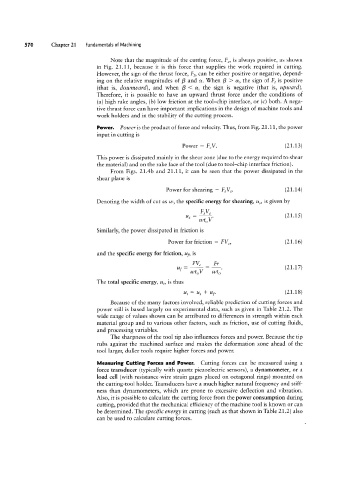Page 589 - 04. Subyek Engineering Materials - Manufacturing, Engineering and Technology SI 6th Edition - Serope Kalpakjian, Stephen Schmid (2009)
P. 589
0 Chapter 21 Fundamentals of Machining
Note that the magnitude of the cutting force, PC, is always positive, as shown
in Fig. 21.11, because it is this force that supplies the work required in cutting.
However, the sign of the thrust force, Ft, can be either positive or negative, depend-
ing on the relative magnitudes of B and oz. When B > ct, the sign of F, is positive
(that is, downward), and when ,G < ot, the sign is negative (that is, upward).
Therefore, it is possible to have an upward thrust force under the conditions of
(a) high rake angles, (b) low friction at the tool-chip interface, or (c) both. A nega-
tive thrust force can have important implications in the design of machine tools and
work holders and in the stability of the cutting process.
Power. Power is the product of force and velocity. Thus, from Fig. 21.1 1, the power
input in cutting is
Power = FCV. (21.13)
This power is dissipated mainly in the shear zone (clue to the energy required to shear
the material) and on the rake face of the tool (due to tool-chip interface friction).
From Figs. 21.4b ancl 21.11, it can be seen that the power dissipated in the
shear plane is
Power for shearing = FSVS. (21.14)
Denoting the width of cut as w, the specific energy for shearing, us, is given by
=f.
FSVS
us wtOV ( 21.15 )
Similarly, the power dissipated in friction is
Power for friction = PVC, (21.16)
and the specific energy for friction, uf, is
= 4* = -.
Fr
PVC
uf wtUV wto l 21.17 l
The total specific energy, u,, is thus
14, = us + uf. (21.18)
Because of the many factors involved, reliable prediction of cutting forces and
power still is based largely on experimental data, such as given in Table 21.2. The
wide range of values shown can be attributed to differences in strength within each
material group and to various other factors, such as friction, use of cutting fluids,
and processing variables.
The sharpness of the tool tip also influences forces and power. Because the tip
rubs against the machined surface and makes the deformation zone ahead of the
tool larger, duller tools require higher forces and power.
Measuring Cutting Forces and Power. Cutting forces can be measured using a
force transducer (typically with quartz piezoelectric sensors), a dynamometer, or a
load cell (with resistance-wire strain gages placed on octagonal rings) mounted on
the cutting-tool holder. Transducers have a much higher natural frequency and stiff-
ness than dynamometers, which are prone to excessive deflection and vibration.
Also, it is possible to calculate the cutting force from the power consumption during
cutting, provided that the mechanical efficiency of the machine tool is known or can
be determined. The specific energy in cutting (such as that shown in Table 21.2) also
can be usecl to calculate cutting forces.

